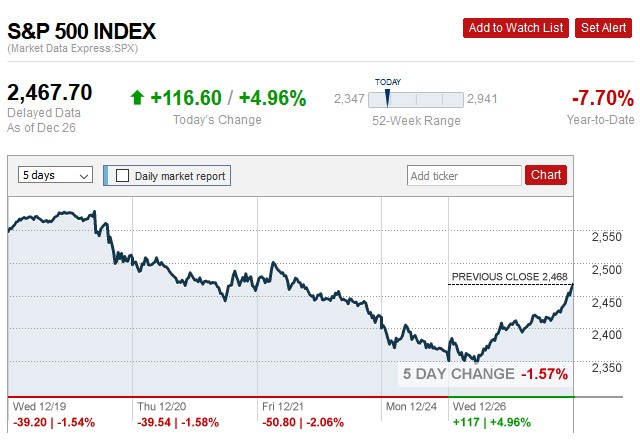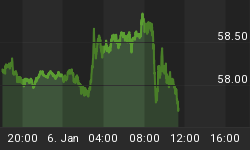U.S. stock markets completed their biggest post-Christmas rally in history and best one-day gain in nearly a decade on Wednesday as a triumvirate of surging oil prices, strong retail indications and positive news from the White House conspired to gift investors an unexpected Christmas bonanza.
The Dow Jones Industrial Average was the highlight of the day after surging 1,086.25 points to close at 22,878.45, the biggest one-day point gain in the index’s history. That was good for a 4.98 percent return—the second-biggest upside move by the index on a percentage basis since it rallied 5.8 percent on March 23, 2009.
The broader market S&P 500 was not far behind either after catapulting 4.96 percent to finish at 2,467.70 as tech, consumer discretionary and energy sectors all rallied more than six percent and triggered biggest one-day rally by the market since March 2009.
Meanwhile, the tech-heavy Nasdaq Composite also put up an impressive show after jumping 5.84 percent to close at 6,554.36, yet another high watermark since March 2009.
Overall, Wednesday marked the biggest post-Christmas rally in U.S. stock markets’ history.



Source: CNN Money
Trump Backs Powell as Retail Shines
It’s perhaps ironic that Wednesday’s rally--a sharp rebound from Monday’s rout--was triggered by the same event—president Trump’s attacks on the Fed.
On Monday, the S&P 500 posted its worst Christmas Eve decline ever after the president lambasted the Federal Reserve in a tweet once again labeling it "the only problem our economy has”.
Related: Bad News Builds For Global Markets
He followed that up on Tuesday by placing the blame for the country’s economic headwinds squarely on the central bank and openly criticizing Fed chair Jerome Powell, "They're raising interest rates too fast because they think the economy is so good. But I think that they will get it pretty soon.’’ Trump blamed interest rate hikes by the Fed for the recent ugly downturn on Wall Street after the bank raised overnight rates four times this year. Sunday’s statement by Treasury Secretary Steve Mnuchin saying, "The banks all confirmed ample liquidity is available for lending to consumer and business markets" certainly did not help matters since it was interpreted by the market as a go-ahead to the Fed to continue tightening.
Trump appointed Powell in November 2017. His latest polemic was seen as a direct threat on Powell’s tenure and appeared to reinforce reports that he might give him the sack. The Wednesday rally came after White House moved to allay those fears with Kevin Hassett, chairman of the White House Council of Economic Advisers, reassuring the market that Powell’s job is “100 per cent” safe, according to media reports.
Meanwhile, strong data coming from the pivotal retail sector as well as a recovery in crude oil prices lent further support for the rally.
Data by Mastercard SpendingPulse showed that retailers remained on course for the best holiday season in six years. U.S. retail sales from Nov. 1 through Christmas Eve clocked in at $850 billion--good for a healthy 5.1 percent year-on-year climb.
Retail heavyweights blazed the trail with handsome gains of 9.45 percent for Amazon while Dollar General, Kohl’s and Wayfair all notched more than seven percent higher on the day. The retail sector performed well in general with the sector benchmark, SPDR S&P Retail ETF (XRT), tucking on gains of 4.7 percent.
The stock market euphoria seems to have rubbed off on the oil market with crude prices jumping the most in years. WTI crude rallied 10 percent at one point in Wednesday’s trading before pulling back to finish the day with an eight percent gain. Energy stocks followed suit with shares of Marathon Oil and Hess Corp. emerging as top performers after racking up gains of 11.9 percent and 11 percent, respectively.
Dead Cat Bounce?
But it’s now beginning to appear like Wednesday’s was a phantom rally and the much-anticipated Santa Rally might get nipped in the bud.
All major indexes are sliding lower on Thursday’s session with the Dow Jones and S&P 500 both slipped 2.46 percent, and the Nasdaq Composite slipping 3.18 percent by 2.15pm ET. This has some makings of a dead cat bounce considering the brevity of the rally and the fact that Monday’s selloff had officially ushered in a bear market.
The S&P 500 entered into bear territory on Dec. 24 for the first time since the 2009 financial crisis after cratering 20.06 percent from an intraday record high set on Sept. 21.
A bear market is a condition where the market falls 20 percent or more from recent highs usually due to negative investor sentiment and widespread pessimism.
According to John Augustine, chief investment officer at Huntington Private Bank, the market needed to rally for at least three consecutive days to stem the current wave of selling.
Unfortunately, that has not happened. Augustine describes the recent stocks selloff as a "… a buyer's strike due to lack of confidence in policymakers around the world."
As Peter Cardillo, chief market economist at Spartan Capital Securities, has noted, president Trump continues to create a lot of uncertainty leading to bargain hunters looking to shop for cheap stocks amid the carnage putting their orders on hold.
As if the China trade war has not wrought enough damage already, investors now have to contend with a government shutdown after Trump doubled down on his earlier pledge to “do whatever it takes” to get Mexico to build a wall on the border. Opponents of the barrier say the wall will not solve U.S.’ immigration issues not to mention that the government shutdown has kicked off with no end game strategy on either side.
By Alex Kimani for Safehaven.com
More Top Reads From Safehaven.com

















